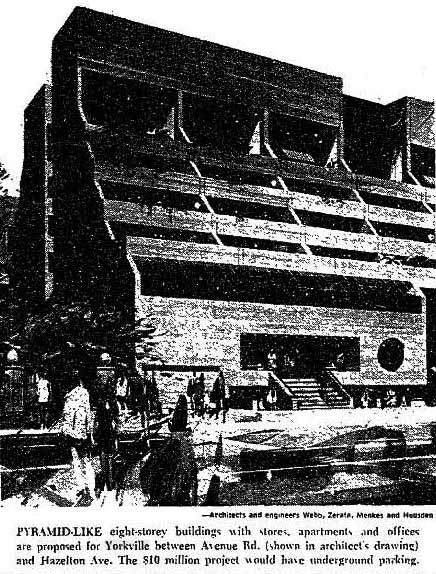bonus features: making and remaking hazelton lanes
This post offers supplementary material for a Torontoist post I recently wrote, which you should dive into before reading any further.
It was nice for a change to read about a development project where the nearby residents weren't convinced the sky was going to fall. Unless there's a secret back story missing from both the media coverage and the personal correspondences I leafed through while researching this article, it sounds like the developer did everything right to reassure the community that all would be well.
Besides the Avenue-Bay-Cottingham Ratepayers' Association, the neighbouring Annex Ratepayers' Association (ARA) was consulted. In a letter to alderman Ying Hope, an ARA representative wanted to "commend the process of community association consultation in the development of the project."
Not that there weren't opponents. In a letter to the city clerk, Hazelton Avenue apartment building owner Mohsen Djelweh complained about the potential traffic bottleneck along his street. He also worried that granting an exception to the 45-foot building height limit would cause Yorkville to "slowly die and convert into a canyon" instead of remaining a "highly regarded, highly attractive low-rise development" which drew tourists.
The loudest opponent to Hazelton Lanes appears to have been alderman John Sewell. This didn't come as a shock - after researching so many stories about 1970s Toronto, I often wonder if Sewell opposed ideas and projects for the sake of opposing. You can build a drinking game around predicting what Sewell will rage against in the midst of the story you're trailing. Besides the height issue (which he was only one of three councilors to vote against in February 1974), Sewell complained that the project offered no provisions for affordable housing. He claimed that developer Richard Wookey "doesn't want to have to touch people who aren't in a fairly high income bracket." Sewell's attempt to promote mixed income housing in Yorkville didn't gain traction.
An example of an early Hazelton Lanes ad campaign. A different batch of tenants was profiled each week. Note the references to the mall's hard-to-find location, which didn't always serve it well.
Here's how Hazelton Lanes was described in The Best of Toronto 1980, published by Toronto Life:
Toronto's most exclusive , multi-purpose structure is a spectacular complex incorporating shops, restaurants, offices and luxury condominium apartments. The courtyard is a skating rink in winter and an outdoor extension of the Hazelton Lanes Cafe in summer. You'll find everything from delicious imported chocolates at Au Chocolat to designer fashions at Chez Catherine. It's elegant, exclusive, expensive and not to be missed.
The ad above was the only colour shot of the rink I could find, even if it is a dark nighttime picture. The ad is part of a long-running campaign from CKFM (now Virgin Radio) depicting scenes around the city. The rink was removed during the late 1990s, and its replacements has ranged from dining spaces to a place to flop down and check your email.
Additional material from correspondences preserved at the City of Toronto Archives and the March 22, 1974 edition of the Toronto Star.
 |
| Source: the Toronto Star, April 5, 1973. |
Besides the Avenue-Bay-Cottingham Ratepayers' Association, the neighbouring Annex Ratepayers' Association (ARA) was consulted. In a letter to alderman Ying Hope, an ARA representative wanted to "commend the process of community association consultation in the development of the project."
Not that there weren't opponents. In a letter to the city clerk, Hazelton Avenue apartment building owner Mohsen Djelweh complained about the potential traffic bottleneck along his street. He also worried that granting an exception to the 45-foot building height limit would cause Yorkville to "slowly die and convert into a canyon" instead of remaining a "highly regarded, highly attractive low-rise development" which drew tourists.
The loudest opponent to Hazelton Lanes appears to have been alderman John Sewell. This didn't come as a shock - after researching so many stories about 1970s Toronto, I often wonder if Sewell opposed ideas and projects for the sake of opposing. You can build a drinking game around predicting what Sewell will rage against in the midst of the story you're trailing. Besides the height issue (which he was only one of three councilors to vote against in February 1974), Sewell complained that the project offered no provisions for affordable housing. He claimed that developer Richard Wookey "doesn't want to have to touch people who aren't in a fairly high income bracket." Sewell's attempt to promote mixed income housing in Yorkville didn't gain traction.
 |
| Advertisement, the Toronto Star, April 14, 1977. Click on image for larger version. |
 |
| Advertisement, Toronto Life, January 1980. Click on image for larger version. |
Toronto's most exclusive , multi-purpose structure is a spectacular complex incorporating shops, restaurants, offices and luxury condominium apartments. The courtyard is a skating rink in winter and an outdoor extension of the Hazelton Lanes Cafe in summer. You'll find everything from delicious imported chocolates at Au Chocolat to designer fashions at Chez Catherine. It's elegant, exclusive, expensive and not to be missed.
The ad above was the only colour shot of the rink I could find, even if it is a dark nighttime picture. The ad is part of a long-running campaign from CKFM (now Virgin Radio) depicting scenes around the city. The rink was removed during the late 1990s, and its replacements has ranged from dining spaces to a place to flop down and check your email.
Additional material from correspondences preserved at the City of Toronto Archives and the March 22, 1974 edition of the Toronto Star.

Comments